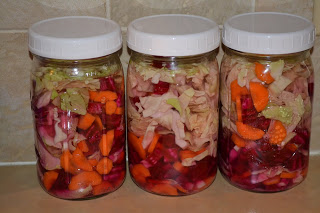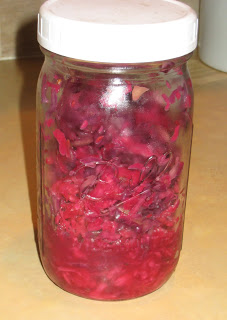It seems I keep learning new stuff every day 🙂 I have read part of Change Your Brain Change Your Life (I still have a lot of reading and learning to do!). And there is a lot of great information. One thing that really stood out to me already was the discussion of the sympathetic vs. the parasympathetic nervous system.
“There are two branches of [the autonomic nervous] system. One of these branches, the sympathetic nervous system, is often referred to as the “fight or flight” branch. It helps you burn energy. The other branch is the parasympathetic nervous system. This branch helps you conserve energy. It also helps you digest food.” (1)
Both in GAPS and CYBCYL I have read about this. And I found that I have major sympathetic dominance. This correlates to OCD, worry, anxiety, etc. It also correlates to slow/poor digestion. When your sympathetic nervous systems is overactive you are often in a fight or flight state. This state shuts down unnecessary processes…as in digestion. I knew that my anxiety made my digestion worse. This just makes it really understandable now. And gives me direction. I need to calm my sympathetic nervous system and stimulate my parasympathetic nervous system (I mentioned this once in an update post after reading about it in the GAPS FAQ). This will let my digestive system function and get rid of the worry. It will help my brain and gut function normally.
So I was doing a little research on diet related to the PNS, and I came across metabolic typing. Bill Wolcott says that different people have different nutritional needs (makes sense). Some people need more protein and fats, while others need more carbohydrates, depending on whether you are sympathetic or parasympathetic dominant. And depending on how your body burns energy. Here is the basic idea behind this type of diet. You can do an online test to see what type of diet you need. Turns out I’m a carbo type…which corresponds to your body functioning best with a high carb, low fat, lower protein diet.
“Generally speaking, if you’re a carbo type you need a higher percentage of carbohydrates in your diet in order to strengthen the parasympathetic branch of your nervous system, which is weaker than your sympathetic system, and thereby alkalinize your too-acid metabolism. Or you need more carbohydrates to speed up your naturally slow cellular oxidation rate, thereby bringing it into balance by acidifying your too-alkaline metabolism.
Carbo types typically do well on a low-fat, relatively low-protein diet — one that includes liberal amounts of carbohydrates in the form of vegetables, fruits and whole grains. However, carbo types need to remember that a “low-protein” diet does not mean a “no-protein” diet. In fact, most carbo types will find that they need to include protein at most meals, but they need to focus on leaner, lighter meats, seafood and poultry than protein types. They should restrict their consumption of red meat in favor of light meat chicken and turkey and lighter seafood such as haddock, cod, perch, sole, catfish and flounder.
If you’re a carbo type you should stick to low-fat dairy products, but you can eat a very wide selection of vegetables, fruits, and grains. However, many carbo types, like protein types, do best by focusing on vegetables that contain low or moderate levels of sugar and starch.”(2)
This is definitely not the way I’ve been eating. By following GAPS I tended to eat a high protein/fat, low carb diet. Not intentionally. That’s just what tends to happen since GAPS is so focused on nourishing animal foods and fats. I’m finding that GAPS tends to be better suited for people with parasympathetic dominance (protein types). And this might be why I struggle so much with too much meat (especially beef) or fat or nuts. I don’t balance it with the proper amount of carbs.
Does this mean I need to start eating tons of bread, pasta, etc.? Absolutely not! Does this mean you can’t do GAPS and follow metabolic typing? No. I have to be more deliberate about my food choices and ratios. Carbs come from vegetables. When I put food on my plate I need to add more vegetables and less meat (the opposite of how I’ve been eating). Grains still may not be the best option for me. I have to try and see. Here is some info from Dr. Mercola on this issue.
“While this is technically correct, if one doesn’t understand the practical distinction between grains and vegetables, one is likely headed for a health disaster. It is important to remember that over two-thirds of Americans are either obese or overweight, and nearly every one of these individuals needs to lower their insulin levels.
Additionally, most people with high blood pressure, high cholesterol and diabetes also struggle with elevated insulin levels that respond quite well to grain restriction.
So what nearly all of these people–likely over 85 percent of the U.S. population–will benefit from is not a low-carb diet (the Atkins Diet), but the grain-free diet outlined in detail in my new book.
So if you are a Carb Nutritional Type™ you will require about 60 percent of your food as carbs, 25 percent protein and 15 percent fat, but this type may need as little as 10 percent fat and as high as 80 percent carbs in exceptional times. If you followed an Atkins Diet you might improve initially but eventually your system would break down because it required far more carbohydrate.
Once a person attains a normal weight and does not struggle with other insulin related disorders, it is actually possible to consume some grains and remain perfectly healthy. Carb types actually can do quite well with grains, but remember this is likely to only be about 15 percent of the population at best.
Don’t stress out about the percentages; they are only rough guidelines. Even if they needed to be precise, you wouldn’t take the time or make the effort to eat exact percentages of foods every single time you ate, especially for the rest of your life.
Additionally, your activity and stress levels will affect and alter the quantity of food, as well as the ratio of proteins, fats and carbohydrates, you need to feel your best.
Last, there is also a circadian rhythm to account for. Your biochemistry moves through various phases throughout the day. These rhythms involve your hormonal output, your acid/alkaline shifts, your waking/sleeping times and many other time-based variables. While some people will have a need for the same ratios of protein, fat and carbs at each meal, others will discover that they need very different ratios at the different meals in order to derive optimum energy, well being and performance” (3)
Here is a guideline of foods that are good for carbo types.
I’ve been so focused on eating protein and fat and grain free that I think I got too low carb (again, not intentionally). While this may have helped seal my gut, it made my PNS even slower…resulting in slower digestion…and not improving my OCD.
What does this all mean? It means I have some experimenting to do. It means I need to be conscious of the ratios of food on my plate. It means I need to increase veggies. It means I’m gradually returning to where I started this journey…a whole/real food balanced diet that does not include processed foods and sugar. At the moment I am still eating a full GAPS diet. But I need to shift it a bit so that I eat plenty of carbohydrates and not quite as much protein and fat. And see if my body handles that better. I would like to add a small amount of properly prepared grains (soaked, fermented, sourdough) as well in the near future and see how I do. I don’t intend to eat “low fat.” I still think I need plenty of healthy fat. But maybe not quite as much as I have been eating and in better balance with my carb intake. I will still eat full fat dairy. I’m not a fan of low fat dairy, especially when nursing and trying to get my hormones in balance. And I don’t intend to eat tons of grains. I don’t think that’s good for anyone. I’m going to try to find the right balance of nourishing food for my body. For now that will focus on shifting from high protein/fat to high carbohydrate. In some ways this sounds like a big change, but in other ways it’s not. Really I just need to eat more vegetables 😛 And I need to be sure I’m not eating sweets. I need to combine all of information I’ve learned over the last couple years with this new information and with what I know about my own body. I still believe in eating lots of nourishing foods like eggs, butter, broth, coconut oil, fish, etc. But the quantities may have to be adjusted for each person’s body/metabolism type. Let the experimentation begin!
I know some people don’t believe in metabolic typing. I can’t say at this point if it does or does not work. But I’m going to try it. I figure I have nothing to lose. If it doesn’t give me improvement, then I find something else. But then again it might help! So this is where I’m at right now. I would also like to try to figure out Rebecca’s metabolic profile to see if I need to adjust her diet. I can’t assume hers is the same as mine. Everyone’s is different. And it can change throughout your life. Again, this is where I’m at for now. I’ll see how it goes and continue to listen to my body while focusing on healthy, real, nourishing food.
I will have to experiment with my ratios. I am a carbo type. But I think I lean a little towards a mixed type too…which would require an equal balance of protein, fat and carbs.
I am curious to see if this has any impact on Abram as well. He has had digestive issues lately, slow digestion. Is it possible that my carb/protein ratios can impact the makeup of my milk in the same way? I guess we’ll see.
There is still more that I’m learning and would like to share at some point. I will be looking into supplements. And I hope to do a series of posts on brain function and tools to overcome problems.
Do you have any experience with metabolic typing? Any thoughts or opinions? I will update as I experiment. But I’d love to hear stories from others as well.
(1) – Alternative Medicine
(2) – The Metabolic Typing Diet
(3) – Mercola




